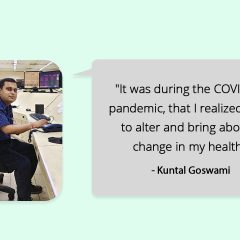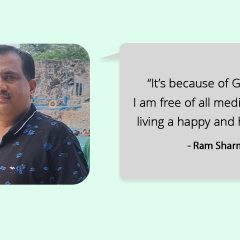 What makes your morning better? Is it the bright morning sun, ushering in a new day with its warm rays? Or the melodious chirping of birds? Is it the fresh aromas of flowers or morning dew? If you thought of a freshly brewed cup of coffee, a newspaper and sitting under a blue sky, then we have a lot in common!
What makes your morning better? Is it the bright morning sun, ushering in a new day with its warm rays? Or the melodious chirping of birds? Is it the fresh aromas of flowers or morning dew? If you thought of a freshly brewed cup of coffee, a newspaper and sitting under a blue sky, then we have a lot in common!
Yes, I orchestrate my mornings with Coffee! If coffee is considered bad and me being a nutritionist, you might wonder why I am starting my day with it? Well, today I am writing to make you believe that, “A bad day with coffee is better than a good day without it!”
Surprisingly, coffee has some amazing hidden benefits which we don’t often address. Apart from the warmth, the energy boost, and freshness, there are a lot more benefits that coffee beans offer.
Let’s Brew the Hidden Benefits of Coffee
- Keeps the Body Cells Healthy: Sipping coffee every morning is like flooding our body with antioxidants that help eliminate free radicals. Not every antioxidant has this power. Only Coffee antioxidants are blessed with the ability to fight and delay the death of cells, so keep sipping!
- Digestion of Carbs Gets Easier: Coffee and carbohydrates work really well together. A few chemicals in coffee beans help the body turn those wonderful bread nutrients into energy. Antioxidants such as chlorogenic acid, quinic acid found in coffee help the body process and utilize carbs effectively. Isn’t that wonderful! Now we know why coffee and sandwiches makes the best pair! It’s all scientific.
- Sip to Kick Stress & Depression Away: Caffeine impacts neurotransmitters in the brain, including the “feel good” hormones serotonin and dopamine. The mental boost we get after the first sip of coffee isn’t all due to caffeine.
- Aids Hair Growth: Growth-promoting effects of caffeine on human hair follicles encourage hair growth in both men and women. Caffeine helps to block the effects of DHT, the chemical hormone responsible for hair loss.
- Improves Performance on Tracks: Sipping coffee as a pre-workout allows muscles to better convert fat to fuel, making you more energized. Try this amazing bulletproof coffee recipe, made popular by our Founder and CEO Vishal Gondal! Trust me, it does wonders!
- Coffee-licious Daily Scrub: What else to ask for? Coffee does wonders as an exfoliant! Mix fresh or ground coffee beans with olive oil or coconut oil, and scrub to get clean, softer skin.
- Good for the Liver: A cup of coffee a day, keeps cirrhosis away. Yes! That is true! Researchers say that coffee protects the liver and reduces the chances for cirrhosis by 80%.
- Green Coffee is a Multitasker: Green coffee is unroasted coffee beans that grow on the coffee plant, called Coffea Arabica. It is rich in antioxidant, increases metabolic rate by 3% to 11%, encouraging weight loss. It is also a natural detox, controls unnecessary food cravings and stops us from overeating.
- White Coffee is NEW in Town: White Coffee comes from the same hard green coffee beans as regular coffee. Not to be confused with the creamy coffee we get in coffee shops, this one is different. The main differences between the two are in the roasting process, roasting time, and the resulting flavor. White Coffee has up to 50% more caffeine, but is less acidic making it easy on the stomach and retaining more antioxidants.
Do these awesome hidden benefits of coffee make you feel like brewing a cup? Just remember that having anything in excess is bad for your health. Drinking too much coffee may do more harm than good. So, limit your coffee intake to only 2 cups a day and avoid sipping on coffee after 7 PM, or it may end up hampering your sleep.
We wish you all a Happy International Coffee Day! How do you enjoy your coffee? Tell us in the comments below.
To know more hidden benefits like this, speak to your GOQii Coach by subscribing for Personalised Health Coaching here.
#BeTheForce
 You must have come across many women among your friends, neighbourhood and even within your family suffering from PCOS, a common endocrine disorder among women of reproductive age. Women with PCOS may have enlarged ovaries that contain small collections of fluid — called follicles — located in each ovary, as seen during an ultrasound exam.
You must have come across many women among your friends, neighbourhood and even within your family suffering from PCOS, a common endocrine disorder among women of reproductive age. Women with PCOS may have enlarged ovaries that contain small collections of fluid — called follicles — located in each ovary, as seen during an ultrasound exam. Ever wondered why we do what we do? Why we get up at dawn on any given day, including Sundays? The reason is simple for many of us: it’s either for running or cycling. It’s like a ritual and a moment for ourselves. If you’re into running or cycling, you’ll connect well with what I’m saying. It’s an addiction—and a good one to have!
Ever wondered why we do what we do? Why we get up at dawn on any given day, including Sundays? The reason is simple for many of us: it’s either for running or cycling. It’s like a ritual and a moment for ourselves. If you’re into running or cycling, you’ll connect well with what I’m saying. It’s an addiction—and a good one to have!
 The global food industry has made preparing meals a breeze. No longer do families need to stress about time-consuming, skillful cooking and the intricate assembling of cereals, pulses, veggies, spices, and herbs to put on a wholesome meal on the table. The array of packaged breakfast cereals available in supermarkets has spoiled us for choice in terms of variety and taste. There’s one for each day of the week and plenty to choose from for special occasions when friends stay over too! Gone are the days when you had to slog it out in your kitchen – chopping, slicing, dicing, soaking, grinding, mixing, fermenting, steaming, and plating – not only to satiate hungry tummies but also to earn compliments on your culinary skills! Oats, muesli, wheat flakes, corn flakes, oatmeal, Weetabix, rice krispies, and the like have replaced uttapams, poha, upma, sabudana khichdi, theplas, appams, chillas, paniyarams, dalia, teezan, and other wholesome delights in Indian homes.
The global food industry has made preparing meals a breeze. No longer do families need to stress about time-consuming, skillful cooking and the intricate assembling of cereals, pulses, veggies, spices, and herbs to put on a wholesome meal on the table. The array of packaged breakfast cereals available in supermarkets has spoiled us for choice in terms of variety and taste. There’s one for each day of the week and plenty to choose from for special occasions when friends stay over too! Gone are the days when you had to slog it out in your kitchen – chopping, slicing, dicing, soaking, grinding, mixing, fermenting, steaming, and plating – not only to satiate hungry tummies but also to earn compliments on your culinary skills! Oats, muesli, wheat flakes, corn flakes, oatmeal, Weetabix, rice krispies, and the like have replaced uttapams, poha, upma, sabudana khichdi, theplas, appams, chillas, paniyarams, dalia, teezan, and other wholesome delights in Indian homes. 


